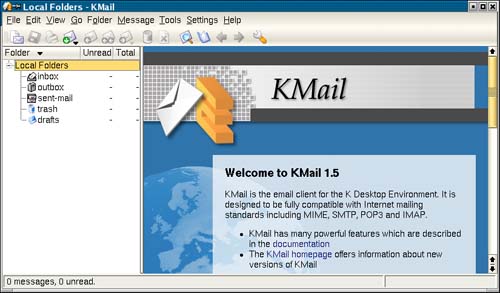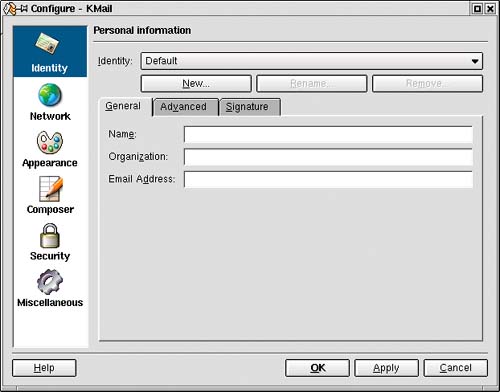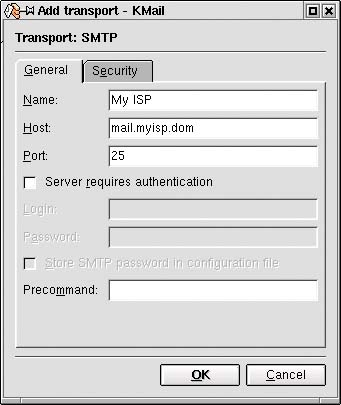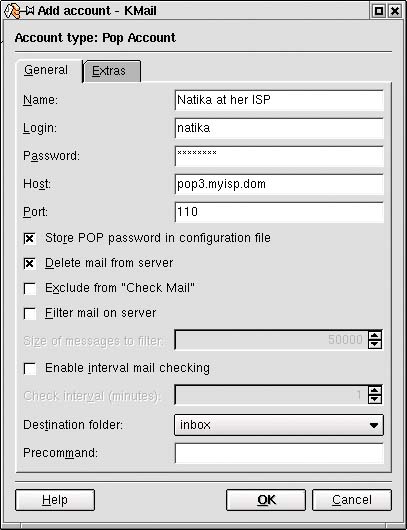Kmail
On a default installation of the KDE desktop, you'll find an icon for Kmail already sitting in your Kicker panel. The icon has an envelope leaning against an orange E. You can also get to it by clicking the big K, looking into the Internet submenu, and selecting Kmail from there.
Shell Out
If you wish to start Kmail from the shell, just type its command, kmail &, at the shell prompt. Alternatively, you can press <Alt+F2> and type the command there. |
The very first time you use Kmail, it will create a directory called Mail in your personal home directory. A dialog box will pop up, asking you to confirm this. Click OK. Kmail will then create some default mail folders for you. These are inbox, outbox, sent-mail, trash, and drafts. You should then see a window similar to the one in Figure 10-1.
Figure 10-1. Kmail as it appears the first time.

Notice the folders listed down the left side. On the right is the main window where you'll read your messages. Before we can actually do anything in terms of sending and receiving email, we need to tell Kmail a little bit about ourselves.
Click on Settings on the menu bar and choose Configure Kmail. Immediately after, you will have to go through a little question-and-answer session. The window to the left contains a handful of sections (Figure 10-2). They are Identity (highlighted by default), Network, Appearance, Composer, Security, and Miscellaneous.
Figure 10-2. Kmail settings configuration.

Notice that there is a drop-down list next to the label that says Identity. That's because Kmail lets you set up multiple identities. This is handy if you use different signatures or return addresses for work and home. For the moment, we'll deal with your default identity.
The layout for email identities is a little different on KDE 3.0 versus 3.1. In 3.0, the tabs are on the screen with the current identity in a drop-down list (Figure 10-2). In KDE 3.1, identities, including the default, are listed alone on the screen. Click Modify first to bring up the tab dialog.
On the General tab, start by entering your name (or what you like to be known as) in the Name: field. If this is your home account, you can probably skip the Organization field if you wish (I've been known to enter silly things here, such as "Dis-Organization"). Then enter your email address.
When you are done here, switch to the Advanced tab and enter your Reply to address (if it is different than your email address). Finally, if you would like a signature to be automatically added when you send mail, click on the Signature tab and enter the information there. Note that you will have to click the Enable signature check box, after which you can enter what you would like to have appear at the end of your emails. Note that there is also a drop-down list so that you can specify a text file with your signature or a program (or script) that automatically generates some kind of (no doubt clever) text dynamically.
The Importance of Being Networked
Now that Kmail knows who you are and what kind of wittiness you like to provide at the end of your communication, you are no doubt anxious to send and receive some mail. For that you need a little network configuration. Click on the Network icon in the Configure Kmail dialog sidebar, and you'll wind up with two tabbed windows on the right-hand side? one for Sending and one for Receiving. Because the Sending tab is selected by default, let's start with that one.
You can actually specify different transports here, as well as different hosts to use for outgoing mail. You are probably already aware that your Linux system isn't your run-of-the-mill operating system. Depending on your distribution's default install, it is quite capable of acting as its own mail server. In fact, notice that there is already one outgoing account setup, that being Sendmail. This is your system's default mail transport, and depending on your network or your ISP, you may simply be able to leave that as it is. Unfortunately, that isn't likely. Most ISPs I know of that service home users don't allow sendmail traffic from their clients to pass through their servers. If you are sending mail, they would prefer that you use their servers. What this means is that you have to click Remove and get rid of the default outgoing account. Now click Add to create a new account. The dialog box shown in Figure 10-3 will appear, asking you to specify a Transport.
Figure 10-3. SMTP server configuration.

Choose SMTP. This will bring up the Add Transport dialog, where you will specify a name for this connection (this is just a name that means something to you, such as "My ISP"), the mail Host (which your ISP or office will provide), and a Port number. Although technically your ISP could run an SMTP host on something other than port 25 (the default), this will likely never happen. Accept the default of 25, click OK, and you are ready to send. That means we are halfway there.
Click on the Receiving tab to prepare Kmail for your incoming mail, then click on the Add button on the right. A small box will appear, asking you for the type of account you want to set up. Your choices are Local Mailbox, POP3, IMAP, and Maildir Mailbox. Most ISPs are still using POP3 as the default mail delivery protocol but this is something you should make sure of. If you are setting your PC up in an office environment, you are likely going to use either IMAP or POP3. When you are happy with your choice, click OK, and you should be presented with the dialog box shown in Figure 10-4.
Figure 10-4. Configuring a POP3 mail account.

The Add Account dialog window will appear, and this is where you configure your account. Please note that you can configure a number of different accounts, and all of them can be accessed through Kmail (just as you could configure many identities).
Start by filling in the Name: field. Once again, this is just a name that makes sense to you, so it can be anything you like. The Login, Password, and Host information will be provided by your ISP or system administrator. As with the SMTP port 25 discussions earlier, although it is possible that your ISP could use something other than port 110 for POP3 (or 143 for IMAP), I can pretty much guarantee that it won't happen. You can safely leave those settings as the default.
Before you go clicking OK in all this excitement, there are a couple of other options you should consider. Notice the check box on the window that says Store POP password in configuration file. Unless you want to be asked for your password each and every time you check your mail, it is probably a good idea to set that here. You probably also want to make sure that you Delete mail from server when you pick up mail.
The last thing I want to point out is near the bottom of the window, the Destination folder. Most people will want to have their new mail arrive in their inboxes. But for those of you who are going to configure multiple accounts and identities (there's a joke there somewhere), this is where you will specify different folders for each of those accounts and personalities?uh, I mean identities.
Click OK when you are done with the account information, then click Apply, then OK to leave the configuration settings.
That is all there is to it. If you are connected to your ISP or through your company LAN, you can start sending and receiving mail. For those who configured an IMAP account, you'll notice a folder with that account's name in your folder list. When you click on the plus sign beside the folder, Kmail will connect to your IMAP server and show you the rest of your folders.







